Slack has revolutionized how teams communicate and work together. As we look at 2025, Slack continues its impressive growth trajectory, cementing its position as a leading collaboration platform.
This comprehensive guide of Slack Statistics breaks down the most important statistics, showing you how Slack drives productivity, improves communication, and shapes the modern workplace.
Table of Contents
ToggleAt a Glance: Slack’s Dominance in 2025
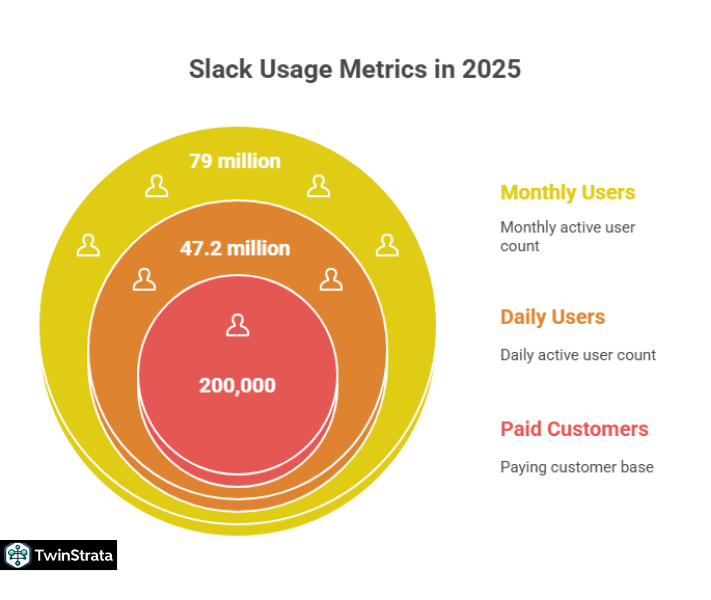
Let’s start with a quick overview of Slack’s key figures for 2025:
- Daily Active Users (DAU): An estimated 47.2 million people use Slack every day.
- Monthly Active Users (MAU): This number climbs to an impressive 79 million.
- Organizations Using Slack: More than 750,000 organizations rely on Slack for their daily operations.
- Fortune 100 Adoption: A remarkable 77% of Fortune 100 companies leverage Slack.
- Paid Customers: Slack boasts 200,000 paying customers, a testament to its value.
- Annual Revenue: Projections show Slack’s annual revenue reaching an estimated $6.98 billion in 2025.
- Valuation: The company holds a strong valuation of $26.51 billion.
- Market Share: Slack commands an 18% market share in the business communications software market.
- Productivity Boost: Teams using Slack report being 47% more productive.
These numbers paint a clear picture: Slack is not just a messaging app; it is a critical driver of efficiency and connectivity in workplaces around the globe.
Getting to Know Slack
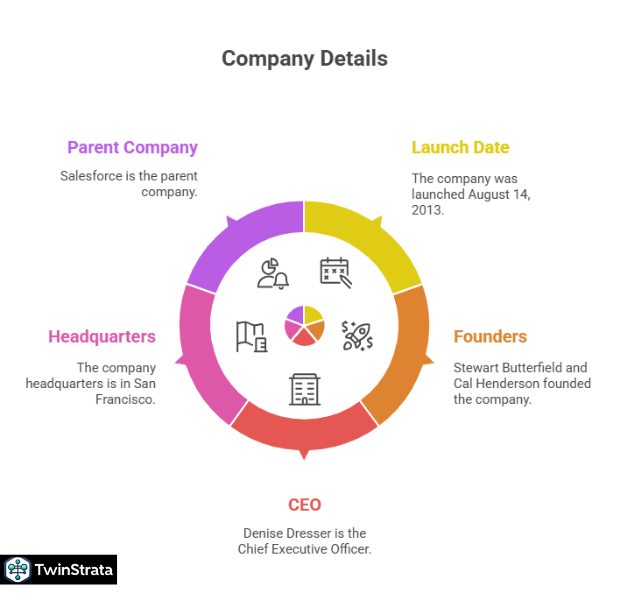
Slack officially launched on August 14, 2013, with Stewart Butterfield and Cal Henderson as co-founders. Today, Denise Dresser serves as CEO, and Salesforce is its parent company, with headquarters located in San Francisco, California.
Here’s a snapshot of Slack’s core details:
| Aspect | Detail |
| Launch Date | August 14, 2013 |
| Founders | Stewart Butterfield, Cal Henderson |
| CEO | Denise Dresser |
| Headquarters | San Francisco, California |
| Parent Company | Salesforce |
| Estimated Daily Active Users | 47.2 million |
| Estimated Monthly Active Users | 79 million |
| Paid Customers | 200,000 |
| Estimated 2025 Revenue | $6.98 billion |
| Valuation | $26.51 billion |
| Number of Employees | Approximately 2,545 |
Source: Statista.
How Many People Actively Use Slack?
Slack experienced explosive growth during and after the pandemic as remote and hybrid work models became the norm. The platform’s user base continues to expand, showing its ongoing relevance and necessity for modern teams.
Daily Active Users (DAU) Soar to 47.2 Million
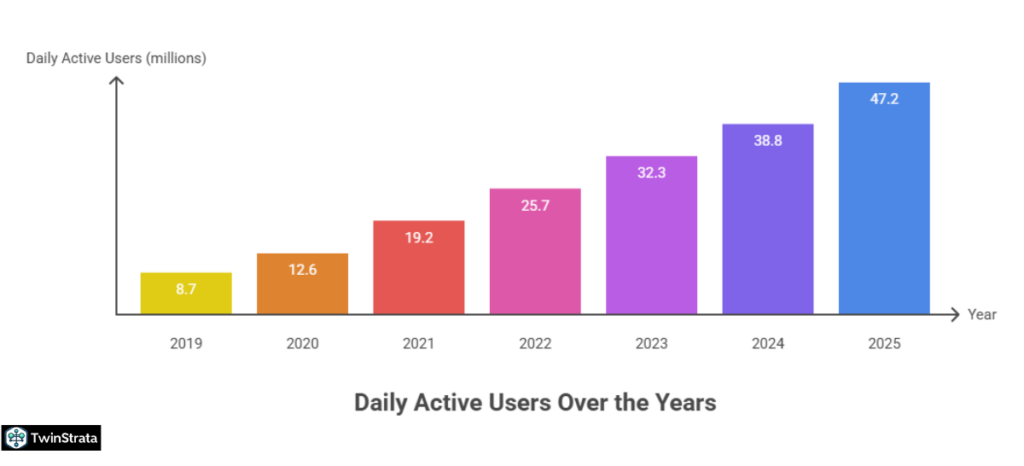
In 2019, Slack reported 8.7 million daily users. Fast forward to 2025, and this figure has skyrocketed to an estimated 47.2 million daily active users. This growth reflects a widespread adoption of the platform as a primary tool for daily work communication.
The following table illustrates Slack’s impressive growth in daily active users over the years:
| Year | Daily Active Users of Slack |
| 2025* | 47.2 million |
| 2024 | 38.8 million |
| 2023 | 32.3 million |
| 2022 | 25.7 million |
| 2021 | 19.2 million |
| 2020 | 12.6 million |
| 2019 | 8.7 million |
Source: Business of Apps.
Monthly Active Users (MAU) Reach 79 Million
The number of monthly active Slack users also shows significant expansion. From 14.6 million in 2019, monthly active users are projected to hit 79 million by the end of 2025.
This surge demonstrates a broad preference for collaborative spaces that enable seamless connection and project collaboration among diverse teams.
Take a look at the consistent rise in Slack’s monthly active users:
| Year | Slack Monthly Active Users |
| 2025* | 79 million |
| 2024 | 65 million |
| 2023 | 54.1 million |
| 2022 | 43.1 million |
| 2021 | 32.2 million |
| 2020 | 21 million |
| 2019 | 14.6 million |
- Also read about: WhatsApp Statistics
Slack’s Robust Revenue in 2025
Slack’s financial performance reflects its strong user growth and value proposition. The platform generates substantial revenue, contributing significantly to Salesforce’s overall success.
Annual Revenue Estimated at $6.98 Billion for 2025
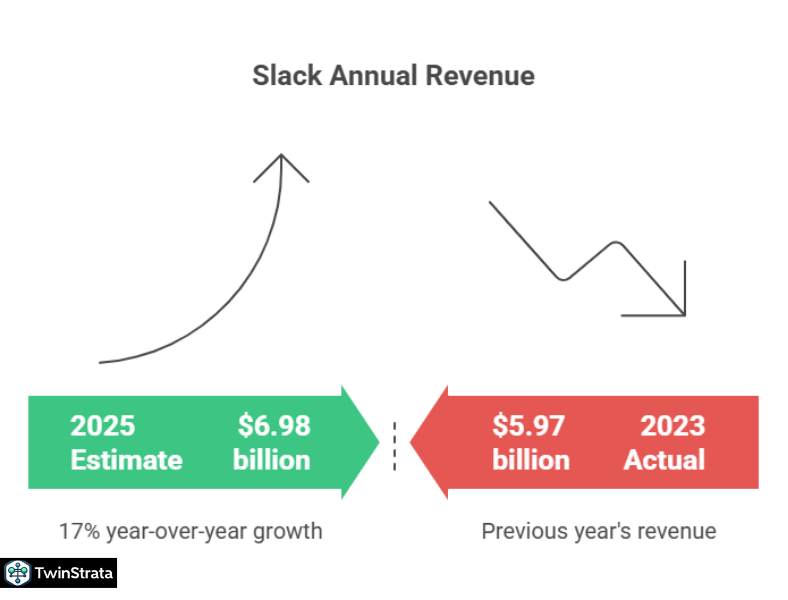
Slack’s annual revenue for 2025 is estimated to reach an impressive $6.98 billion. This represents a healthy 17% year-over-year growth from $5.97 billion in 2023.
This continuous upward trend highlights Slack’s solid financial standing and its crucial role in the business communication market.
Slack’s revenue has grown dramatically since its early days:
| Fiscal Year | Revenue Generated By Slack |
| 2023* | $5,967 million |
| 2022* | $4,509 million |
| 2021* | $3,324 million |
| 2020 | $902.6 million |
| 2019 | $630.4 million |
| 2018 | $400.6 million |
| 2017 | $221 million |
| 2016 | $200 million |
| 2015 | $100 million |
| 2014 | $30 million |
| 2013 | $12 million |
*Note: Since Salesforce acquired Slack, Slack’s revenue integrates into Salesforce’s “Platform and Other” segment. The figures for 2021-2023 represent this combined segment.
Revenue Growth: A Steady Performance
While Slack’s growth rate peaked during the pandemic, it has stabilized to a solid 17% in Fiscal Year 2025. This consistent growth demonstrates Slack’s resilience and ongoing appeal to businesses.
Here is a breakdown of Slack’s revenue growth rates:
| Year | Growth |
| FY 2025 Q2 | 17% |
| FY 2025 Q1 | 17% |
| FY 2024 Q4 | 16% |
| FY 2024 Q3 | 18% |
| FY 2024 Q2 | 16% |
| FY 2024 Q1 | 20% |
| FY 2023 Q4 | 33% |
| FY 2023 Q3 | 46% |
- Also read about: WeChat Statistics
Organizations Embracing Slack
Slack’s widespread adoption by organizations of all sizes underscores its versatility and effectiveness as a business tool. From startups to Fortune 100 giants, companies are increasingly turning to Slack to streamline their internal communications and project management.
Over 750,000 Organizations Trust Slack
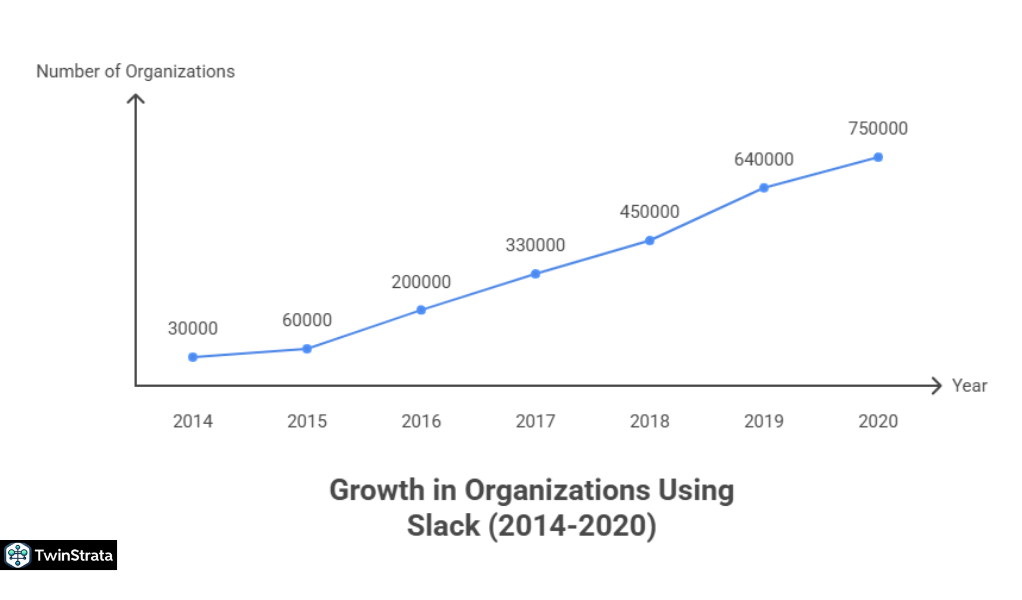
The number of organizations using Slack has seen tremendous growth, reaching over 750,000 today. This includes nearly 80% of Fortune 100 companies, such as IBM, Amazon, Airbnb, and PayPal. While many of these organizations use the free version, their reliance on Slack showcases its universal appeal.
Here is how the number of organizations using Slack has grown:
| Year | Number Of Organizations Using Slack |
| 2020 | 750,000 |
| 2019 | 640,000 |
| 2018 | 450,000 |
| 2017 | 330,000 |
| 2016 | 200,000 |
| 2015 | 60,000 |
| 2014 | 30,000 |
200,000 Paid Customers Drive Premium Features
Slack currently serves 200,000 paid customers, marking a significant 39% year-over-year increase. The shift to remote work during the pandemic encouraged many enterprises to invest in Slack’s premium features, recognizing the enhanced communication and task management capabilities it offered.
The steady increase in paying customers highlights the value organizations find in Slack’s advanced functionalities:
| Year | Paying Customers |
| 2023 | 200,000 |
| 2022 | 169,000 |
| 2021 | 156,000 |
| 2020 | 112,000 |
| 2019 | 88,000 |
| 2018 | 60,000 |
| 2017 | 50,000 |
How People Use Slack: Usage Statistics
Beyond raw user numbers, understanding how people use Slack reveals its impact on daily work life. Slack transforms communication, boosts productivity, and fosters stronger team cultures.
1. Users Spend Over 90 Minutes Actively Working on Slack Daily
On average, users dedicate more than 90 minutes to actively working on Slack each day. This active engagement encompasses sending messages, commenting on documents, and building custom applications.
Every week, users complete over 5 billion actions on the platform, with more than 1 billion of these actions occurring on mobile devices. Slack users stay signed in for approximately 9 hours on weekdays, generating over one billion usage minutes daily.
2. More Than 1.5 Billion Messages Sent Daily
Slack is a messaging powerhouse, handling over 1.5 billion messages daily. This constant flow of communication significantly enhances collaboration.
A remarkable 87% of Slack users report that conversations on Slack improved their organization’s communication quality. Furthermore, 74% of users send messages through public channels, fostering transparency and collective knowledge sharing.
Companies using Slack also see tangible benefits:
- A 13% increase in arranged contracts.
- A 32% reduction in emails.
- A 27% decrease in meetings.
- Support tickets reduced by 2,500 per week.
- Slack API integrations smoothly handle over 3,800 queries per week.
3. Teams Using Slack Are 47% More Productive
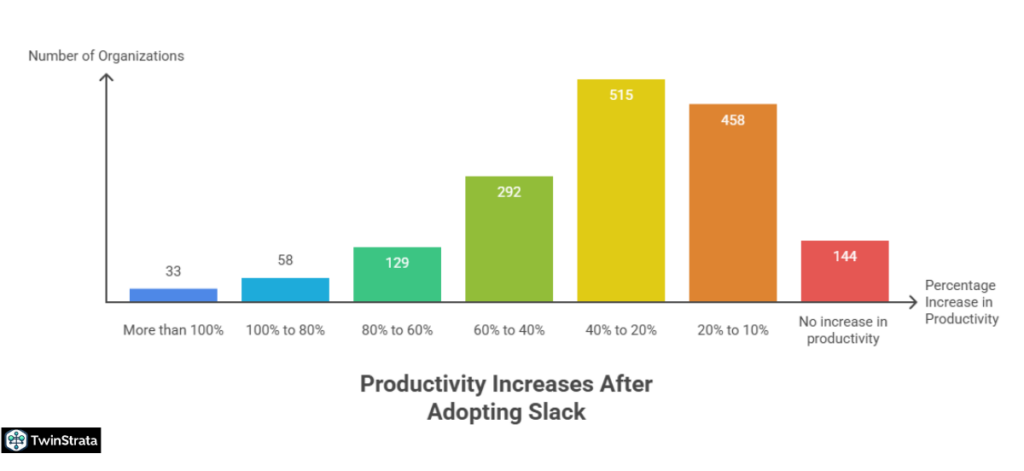
Productivity is a key outcome for Slack users. Teams utilizing Slack are 47% more productive than those not using the platform. A survey of 515 organizations revealed a 20% to 40% increase in team productivity after adopting Slack. Beyond daily tasks, companies using Slack bring their products to market 23% faster than competitors.
Here’s how organizations reported productivity increases after adopting Slack:
| Percentage Increase In Productivity | Number Of Organizations |
| More than 100% | 33 |
| 100% to 80% | 58 |
| 80% to 60% | 129 |
| 60% to 40% | 292 |
| 40% to 20% | 515 |
| 20% to 10% | 458 |
| No increase in productivity | 144 |
4. Slack Improves Team Culture and Remote Work
Slack’s impact extends beyond productivity to company culture. 79% of organizations report that using Slack improved their team culture.
Additionally, an overwhelming 91% of users say their ability to work remotely improved after adopting Slack. This highlights Slack’s role in fostering connectivity and morale, especially in distributed teams.
The effect of Slack on team culture:
| Effect On Team Culture | Percentage Of Organizations |
| Improved team culture | 79% |
| No difference in team culture | 10.6% |
| Don’t know if it affected team culture | 10.4% |
Slack App Statistics: On the Go and Integrated
The Slack app plays a vital role in its ecosystem, enabling users to stay connected and productive from anywhere.
Android App Surpasses 10 Million Downloads
As of March 2023, the Slack Android app exceeded 10 million downloads, demonstrating its widespread adoption on mobile devices. In February 2023 alone, the app saw 900,000 downloads across both iOS and Android.
Slack is a top performer among productivity and communication apps, integrating with various other tools users frequent, such as WhatsApp, Gmail, LinkedIn, and Zoom.
Website Traffic: Desktop Dominates
While mobile usage is high for actions, most direct website traffic to Slack still originates from desktop users. In October 2024, 95.58% of visits were from desktops, compared to 4.42% from mobile devices.
This suggests that while quick actions happen on mobile, deeper engagement and initial setup often occur on desktops.
Slack’s Valuation: A Multi-Billion Dollar Company
Slack’s market valuation has grown tremendously, reflecting its strategic importance and strong market position.
Slack Is Valued At $26.51 Billion
Currently, Slack holds a valuation of $26.51 billion, making it one of the most valuable companies globally by market capitalization. This impressive figure underscores its significant influence in the tech and collaboration sectors.
Slack’s valuation journey over the years:
| Year | Valuation Of Slack |
| 2024 | $26.51 billion |
| 2023 | $26.5 billion |
| 2020 | $27.7 billion |
| 2019 | $23 billion |
| 2018 | $7.1 billion |
| 2017 | $5 billion |
| 2016 | $3.8 billion |
| 2015 | $2.8 billion |
| 2014 | $1.1 billion |
Market Share: A Leader in Business Communication
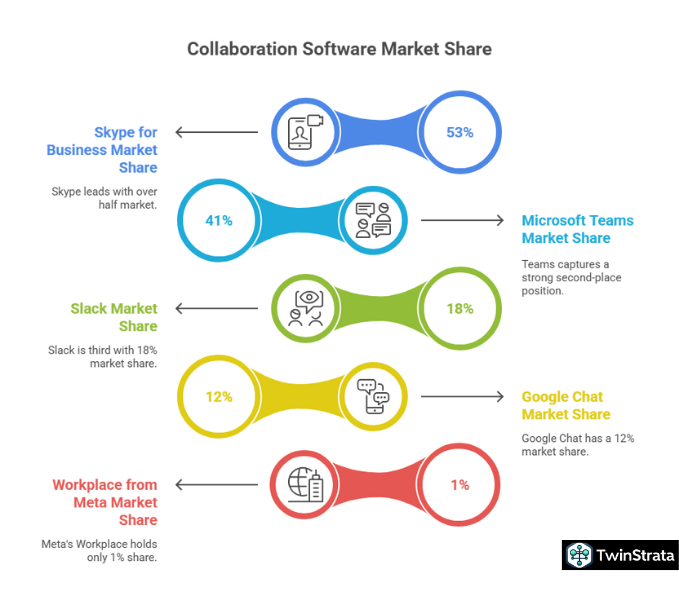
Slack has carved out a substantial market share, proving its popularity and effectiveness against strong competitors.
Slack Commands an 18% Market Share
Nearly one in five people prefer Slack for collaboration and communication. Slack holds an 18% market share in the business communication software market, positioning it as a strong contender against giants like Microsoft Teams and Skype for Business.
Here’s how Slack compares to other collaborative software in terms of market share:
| Collaborative Software | Market Share |
| Skype for Business | 53% |
| Microsoft Teams | 41% |
| Slack | 18% |
| Google Chat | 12% |
| Workplace from Meta | 1% |
Slack vs. Microsoft Teams: A Closer Look
Microsoft Teams and SharePoint stand as Slack’s primary competitors, offering similar functionalities but with distinct features. Teams, for example, integrates web conferencing and online meetings more natively.
Let’s compare some key metrics:
| Parameters | Microsoft Teams | Slack |
| Monthly Active Users | 320 million | 79 million |
| Market Share | 41% | 18% |
| Revenue (estimated) | Over $8 billion | $6.98 billion |
While Microsoft Teams boasts a larger user base, driven by its integration with the broader Microsoft 365 ecosystem, Slack maintains a strong and loyal user base with high engagement.
Here’s a look at the daily active users for both platforms over the years:
| Year | Daily Active Users Of Microsoft Teams | Number Of Daily Active Users Of Slack |
| 2023 | 280 million | 32.3 million |
| 2022 | 270 million | 25.7 million |
| 2021 | 145 million | 19.2 million |
| 2020 | 75 million | 12.6 million |
| 2019 | 20 million | 8.7 million |
| 2018 | 8 million | 8 million |
| 2017 | 2 million | 6 million |
Slack’s Global Footprint and Workforce
Slack is a truly global platform, connecting teams across continents and cultures.
Available in Over 150 Countries and 12 Languages
Slack supports users in more than 150 countries and is available in 12 languages, including English, Spanish, French, Italian, Japanese, and Korean. This extensive reach allows diverse teams worldwide to collaborate effectively.
A Growing Workforce
In 2020, Slack reported having 2,045 staff, growing from approximately 1,664 in 2009. The majority of employees work at its California headquarters, but Slack maintains 11 offices in 7 countries globally, including New York City, Denver, Toronto, London, Paris, Tokyo, Dublin, Vancouver, Pune, and Melbourne.
This global presence supports its vast user base and continuous innovation.
Industry Usage and Demographics
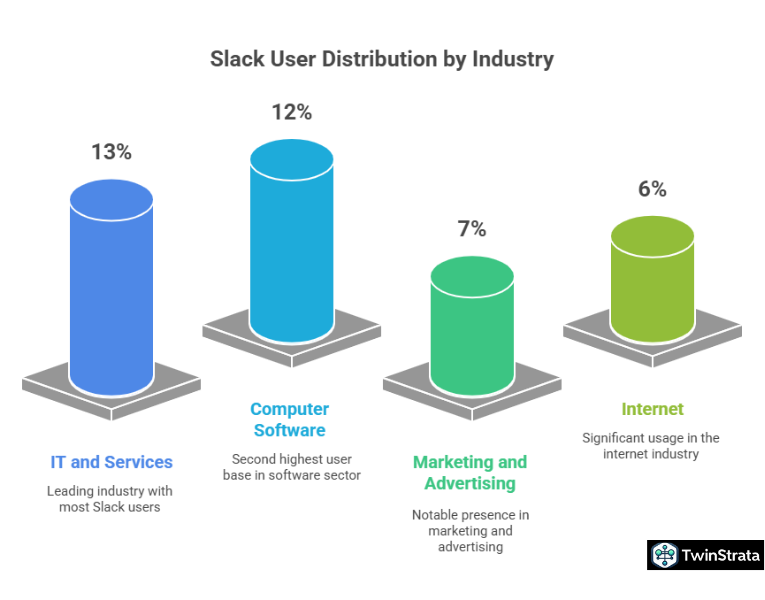
Slack’s versatility makes it valuable across a wide range of industries and user demographics.
Diverse Industry Adoption
Slack finds extensive use across various sectors:
- IT and Services lead with 13% of Slack users (16,577 active users).
- Computer Software follows closely at 12% (15,480 active users).
- Marketing and Advertising accounts for 7% (9,551 users).
- The Internet sector uses it at 6% (7,452 users).
Other significant industries include Financial Services, Retail, Design, Non-Profit Organizations, Real Estate, and Construction.
Companies with annual revenues between $1 million and $10 million represent the largest group of Slack users, with 63,035 organizations. This shows Slack’s strong appeal to growing businesses.
Balanced Demographics
Slack’s user base shows a remarkably balanced gender distribution, with 48.36% identifying as female and 51.64% as male.
The largest age group using Slack is 25-34 years old (33.29%), followed by 35-44 years (20.54%), and 18-24 years (15.25%). This indicates that Slack effectively caters to a diverse, professionally active population.
What Users Are Asking: Latest Insights from Quora and Reddit
Beyond the statistics, what are real users talking about? Recent discussions on platforms like Quora and Reddit reveal key trends and concerns that shape Slack’s future:
- AI Integration and Automation: Users are increasingly asking about Slack’s capabilities to integrate with more advanced AI tools for automating routine tasks, summarizing conversations, and generating content directly within channels. This points to a desire for Slack to become an even smarter “co-worker.”
- Enhanced Huddles and Video Conferencing: While Slack Huddles are popular for quick audio calls, users seek more robust video conferencing features, akin to dedicated platforms, but seamlessly integrated. This includes better screen sharing, virtual backgrounds, and larger participant capacities.
- Cross-Organizational Collaboration (Slack Connect Expansion): Many users express a need for easier, more secure, and scalable ways to collaborate with external partners and clients beyond direct channels, suggesting an appetite for advanced “Slack Connect” features that manage external projects and shared workflows more effectively.
- Advanced Search and Knowledge Management: With the sheer volume of information in Slack, users are constantly asking for more intelligent search functionalities, improved file organization, and ways to turn conversations into structured knowledge bases, highlighting the challenge of information overload.
- Customization and Personalization: From custom themes for different workspaces to more granular notification controls and personalized AI-driven recommendations, users want Slack to adapt more precisely to their individual workflows and preferences.
These discussions indicate that while Slack excels at real-time communication, users are looking for it to evolve into an even more powerful, intelligent, and customizable hub for all aspects of work, especially as hybrid and remote work solidify.
FAQs About Slack Statistics
1. How many daily active users does Slack have in 2025?
Slack is estimated to have 47.2 million daily active users in 2025, showing significant growth from previous years and highlighting its widespread adoption for daily communication.
2. What is Slack's projected annual revenue for 2025?
Slack’s annual revenue is projected to reach an estimated $6.98 billion in 2025, reflecting a consistent growth trajectory and its strong financial performance within the business communication market.
3. How does Slack impact team productivity and communication?
Teams that use Slack report being 47% more productive, and 87% of users say that conversations on Slack improved their organization’s communication quality; it also helps reduce emails by 32% and meetings by 27%.
4. What is Slack's market share in the business communication software market?
Slack holds an 18% market share in the business communication software market, positioning it as a key player alongside competitors like Microsoft Teams and Skype for Business.
5. How has Slack influenced remote work and team culture?
Slack has significantly improved the ability to work remotely for 91% of its users, and 79% of organizations have reported that using Slack positively impacted their team culture, fostering better connectivity and morale.
Also Read:
- Pinterest Statistics
- Tumblr Statistics
- Threads Statistics
- Google Chrome Statistics
- LinkedIn Statistics
Conclusion: Slack Remains Indispensable in 2025
As we navigate 2025, Slack continues to demonstrate its vital role in the modern workplace. With an estimated 47.2 million daily active users across 150 countries and support for 12 languages, Slack connects teams on a global scale.
Users remain highly engaged, spending over 90 minutes actively working on the platform each day and exchanging more than 1.5 billion messages daily.
Slack does more than facilitate communication; it actively improves work processes. It helps companies reduce emails by 32% and meetings by 27%, leading to more focused work. Moreover, Slack has a positive impact on company culture, with 79% of organizations reporting improvements and 91% of users finding their remote work ability enhanced.
With a strong valuation of $26.51 billion and its integration into the Salesforce ecosystem, Slack stands as a powerful, indispensable tool for high-performing organizations worldwide. Its continued evolution, driven by user needs for AI integration and enhanced collaboration, ensures its place at the forefront of business communication.
